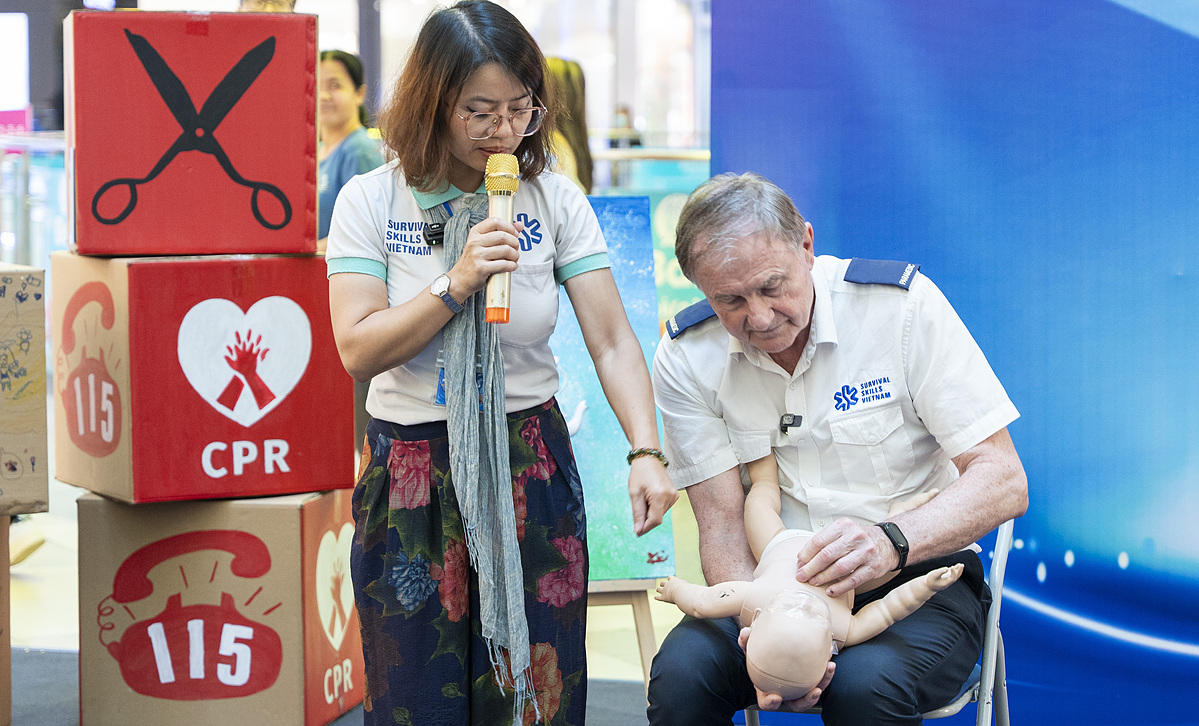"First aid is an essential skill everyone should have, and it's not as complicated as many think. Life-threatening emergencies can happen at any time," said Tony Coffey, an Australian paramedic, at the "Quick Hands, Hold onto Miracles" event in Ho Chi Minh City on 7/8.
Through years of training in Vietnam, Coffey observed that many people are unsure what to do when encountering someone needing emergency first aid. The common mindset is: "First aid is difficult, I'm not a doctor, what if I make it worse?" This fear causes hesitation, leading to inaction and missing the crucial window of opportunity to save a life – potentially that of a loved one, colleague, or friend.
According to the expert, with proper guidance, anyone can perform simple yet vital actions such as placing an unconscious person in the recovery position, performing CPR, applying pressure to stop bleeding, or temporarily immobilizing a suspected fracture. These seemingly small acts can make the difference between life and death in mere moments.
 |
People are instructed on how to use an automated external defibrillator (AED). Photo: Trang Nguyen |
People are instructed on how to use an automated external defibrillator (AED). Photo: Trang Nguyen
However, in Vietnam, many still rely on instinct or anecdotal folk remedies, leading to regrettable mistakes. Some instances include holding drowning victims upside down, causing further choking, inserting fingers into the mouths of those having seizures, potentially causing injury, or manipulating or moving individuals with suspected fractures, exacerbating the injury. Misunderstanding the body's mechanisms and basic first aid principles can sometimes make attempts to help counterproductive.
For example, at the event, during a simulated scenario involving a man choking on food, two women were invited on stage to demonstrate first aid. Both chose to repeatedly pat the victim's back. When asked why, one explained, "Whenever I coughed, my mother would pat my back." The other said she did this hoping it would help the food go down easier, not knowing any other method.
In reality, patting the back while a victim is choking and still coughing can be counterproductive. When someone is choking and coughing, their body is attempting to expel the foreign object. Patting their back at this time could lodge the object deeper into the trachea, completely obstructing the airway and posing a life-threatening risk. Instead of patting, the victim should be encouraged to lean forward, take deep breaths, and cough forcefully to create natural pressure to dislodge the object.
If the choking victim stops breathing and coughing, 5 back blows should be administered, alternating with 5 chest compressions, repeating the cycle until the object is dislodged or the victim shows signs of breathing again.
In Australia, children learn basic first aid techniques from the age of 6. From age 10, they practice age-appropriate procedures of increasing complexity. Coffey hopes every family will have at least one member trained in first aid and suggests Vietnam should install AEDs in public places, a practice Australia implemented 25 years ago. These devices are simple to use: just turn them on and follow the instructions.
 |
Tony Coffey demonstrates first aid for choking infants. Photo: Trang Nguyen |
Tony Coffey demonstrates first aid for choking infants. Photo: Trang Nguyen
Trang Jenna Nguyen, co-founder of Survival Skills Vietnam (SSVN), emphasized the importance of understanding the sequence of the most rapidly fatal causes in first aid to prioritize treatment. When encountering an unconscious victim after an accident, assessment should follow the ABCs: airway, breathing, circulation (bleeding), burns, and major fractures.
With an unconscious victim lying on their back, the first step is to check for breathing, not shaking or checking for injuries. If they are breathing, they should be placed in the recovery position to protect the airway. If they are not breathing, CPR should be started immediately. Next, address any bleeding, as rapid blood loss can be fatal.
In specific cases, like post-accident scenarios with heavy bleeding and cardiac arrest, stopping the bleeding should take precedence over CPR. If two people are available to assist, one should perform CPR while the other addresses the bleeding.
Burns, especially airway burns, are the next leading cause of rapid death, followed by major fractures like those of the femur or pelvis. If a fracture is suspected, the victim should never be lifted, moved, or have the bone manipulated. Instead, the injury should be immobilized to prevent further damage or shock.
"When an accident occurs, everything is fragile, and many are left with regrets, saying 'if only'," Nguyen said, adding that life or death often hinges on a few minutes and one's own actions, not on miracles.
Le Phuong












